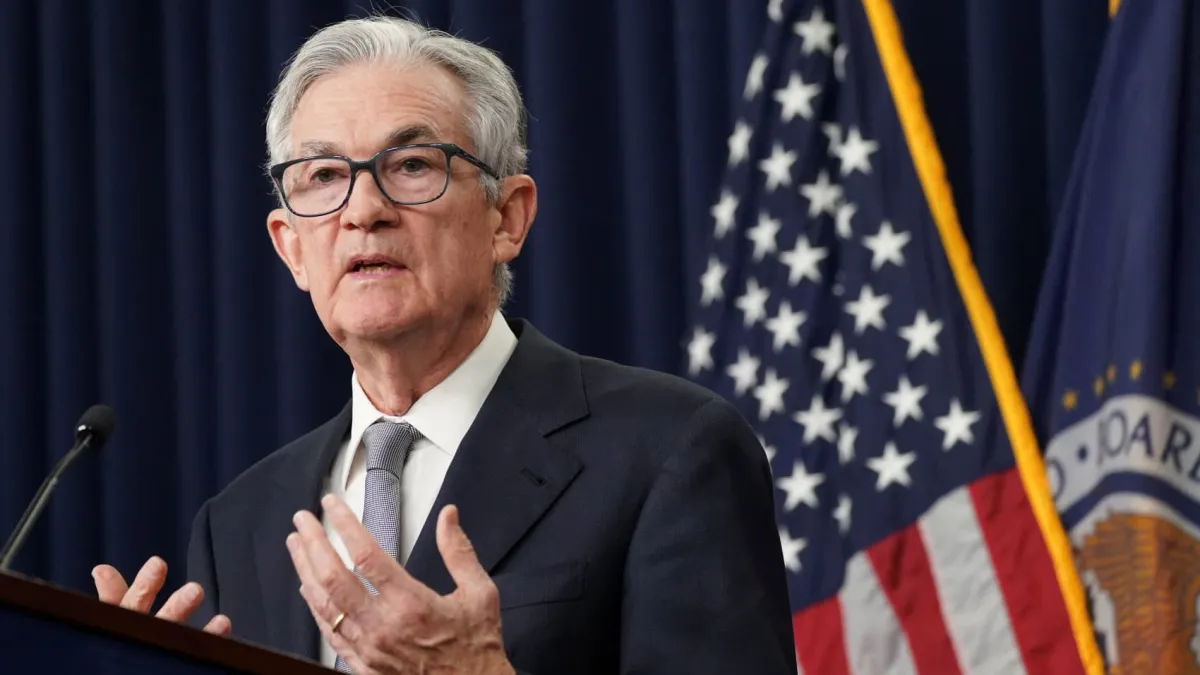Rate cuts, an increased chance of a soft landing and lower inflation — the outlook for next year is looking up in the CNBC Fed Survey, to a point.
Respondents to the CNBC Fed Survey see the Federal Reserve beginning rate cuts next year, though not as aggressively or as quickly as markets have priced in. June is the first month for which more than half of respondents have a reduction built in, rising to 69% by July. Overall, the average respondent forecasts about 85 basis points of cuts next year, roughly one 25 basis point trim a quarter, but not as much as the 120 basis points built into futures markets.
“The Fed needs to begin laying out a road map to rate cuts that may represent tighter policy since cuts will be lagging the decline in inflation and real rates will be rising,” writes John Ryding, chief economic advisor to Brean Capital, in response to the survey.
Kathy Bostjancic, chief U.S. economist at Nationwide, writes in, “The markets have prematurely priced in high odds of rate cuts starting in Q1, but we do expect further steady disinflation will lead the Fed to begin rate cuts around mid-year.”
Like the Fed itself, the 35 respondents to the survey, including economists, strategists and analysts, separate into hawks and doves on the issue of rate cuts next year.
“I still believe (Powell) has the memories of the 1970s in his mind and will be more stubborn in keeping monetary policy tight for longer than markets want him to be,” said Peter Boockvar, chief investment officer at Bleakley Financial Group.
But Michael Englund of Action Economics writes in, “The U.S. headline y/y inflation metrics will fall sharply into early-2024 thanks to weakness in energy prices and easier comparisons, leaving the Fed with significant elbow room to start tightening even if core year over year inflation rates remain firm.”
Soft landing chances
Respondents boosted the probability of a soft landing to 47%, up 5 points from the October survey. They lowered the probability of a recession in the next year by 8 points to 41%, the lowest since the spring of 2022.
Still, the average respondent sees the unemployment rate rising to 4.5% next year and gross domestic product coming in just below 1%, or about half of potential, showing that all is not rosy with the forecast and that an economic slowdown remains the baseline forecast for the group.
“A softening in hiring, income growth, and confidence all point to reduced consumer and business spending,” says Joel Naroff of Naroff Advisors.
But Diane Swonk, chief economist at KPMG, writes in: “The U.S. consumer has proven itself a worthy adversary to everything the Fed has dealt it in its fight against inflation. The key is for a ‘Rocky’ ending, with the consumer still standing and able to leave the ring and heal, once the Fed rings the final bell and starts to cut rates.”
Inflation is forecast to decline on average to 2.7% by the end of next year, down from an expected year-end level of 3.2% for the consumer price index. About a third of respondents forecast the Fed will hit its 2% inflation target next year, 37% say it will happen in 2025 and 28% say it will happen after 2025 or never.
“For the FOMC in 2024, 3.5% inflation is acceptable, recession is not,″ says Steven Blitz, chief U.S. economist at TS Lombard. “With 61% of adults owning equities, the highest since 2008, the Fed is not going to sacrifice faith in equities on the altar of 2% inflation.” Fed officials have insisted they will continue to pursue 2% as their inflation target.
Modest market expectations
Another wild card for next year is whether the Fed ends quantitative tightening in which it has been reducing its balance sheet to tighten monetary policy by allowing the bonds on its balance sheet to mature without replacing them. On average, respondents see the Fed halting QT in November 2024. But that average masks a wide disparity in views, with 55% saying it will happen in 2024 (evenly divided between the first and second half of the year), 30% saying it will happen in 2025 or later and 13% saying they don’t know.
The Fed is seen stopping QT with its balance sheet at $6.2 trillion, compared with the current level of $7.7 trillion and with bank reserves at $2.6 trillion, down from the current level of $3.4 trillion. At $95 billion a month in QT, that implies another eight or nine months of QT to reduce bank reserves to the average expected level. Fed officials have not specified a level, but respondents believe they could announce an end to QT as soon as August and will likely taper QT, or gradually reduce the amount of runoff, before bringing it to an end. When the Fed announces the end of QT, 56% believe it will also say that it will allow all of its mortgage and agency-backed securities to roll off of its balance sheet, 15% say it won’t and 29% do not know.
Respondents to the CNBC Fed Survey see the S&P rising above 5,000 for the first time, on average, but not until the end of 2025. They forecast only a modest gain through 2024 of less than 2% from the current level to 4,696. But much depends on the economic growth: 47% see stocks as overpriced if there’s a soft landing, compared with 91% who say stocks are overpriced if there’s a recession.
Subodh Kumar, president, Subodh Kumar & Associates, sees the market in a period of limbo, unable to break out either way: “The equity markets … appear neither able to reach beyond the highs set at year-end 2021 nor do they appear to be willing to sustain a classical correction,” he wrote.
Barry Knapp, managing partner at Ironsides Macroeconomics, says, “Equities are expecting a ‘V’ shaped earnings recovery, an outcome that is unlikely with contracting bank credit.”

